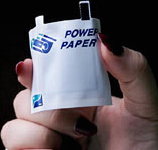By Jennifer Maselli
Aug. 5, 2003 – Power Paper, a Tel Aviv-based company that is developing environmentally friendly, thin-film batteries, has raised $15 million in a fourth round of funding.
The company says it will use the money to continue to develop its flexible, thin batteries for RFID tags and smart labels.
UK-based Amadeus Capital Partners led the round of funding. Other contributors included Poly Technos Funds, Millennium Materials Technology Funds, Banc America Capital Partners, Toppan Forms, Yasuda Enterprise Development Co. and several current shareholders. The new funding brings to $29 million the total amount raised by Power Paper to date.
The company has four divisions: PowerNovelties, PowerCosmetics, PowerInks and PowerID. PowerID is developing the thin-film batteries for active RFID tags. The money will be used to develop thin-film batteries for products in all of these areas. But the company clearly sees smart active RFID labels as a big potential market.
Active (battery-powered) RFID tags are used in the supply chain to track the location of products moving through the supply chain, or of larger assets, such as shipping containers. The battery can be used to broadcast a signal back to the reader, thereby increasing the range from which a unique serial number on the RFID tag can be read.
Today, most active labels are the size of a candy bar or larger and cost $10 or more. The battery accounts for a large portion of the price. A low-cost, paper-thin battery that could be integrated into a label would make it possible to track many more items over longer distances. Power Paper has licensed the technology to Graphic Solutions, a Burr Ridge, Illinois-based custom print house, which says it can produce smart active labels for 50 cents to $1.20 in high volume. Moreover, since the batteries do not contain harmful chemicals, the smart labels can be thrown away with cartons or packaging.
Power Paper plans to offer two RFID-based Smart Active Label systems. The PowerIDT System uses battery-assisted backscattering, which means the tag is still drawing power from the reader and reflecting back a signal. But the battery helps boost the read range. The PowerIDT system could be used with existing RFID readers for passive tags. That means the smart labels could be added to a system cost-effectively to scan pallets as they leave the warehouse or merchandise as it’s loaded onto a truck, for example.
The PowerIDT Plus System uses an active (battery-powered) micro-RF transceiver, which means the tag is actually broadcasting its signal to the reader. That improves read range greatly. These tags can be read from or written to from hundreds of feet away. They can be integrated with sensors that can monitor and record the temperature or humidity of the goods over time. Companies can customize the data they receive and how often they’d like the system to transmit that data.
The two smart active label systems will be commercially available in 2004. “The first demonstration systems will be ready by the end of this year,” says Julie Zuckerman, a spokesperson for Power Paper. “We are working with other third-parties, but I can’t disclose those yet. ”


